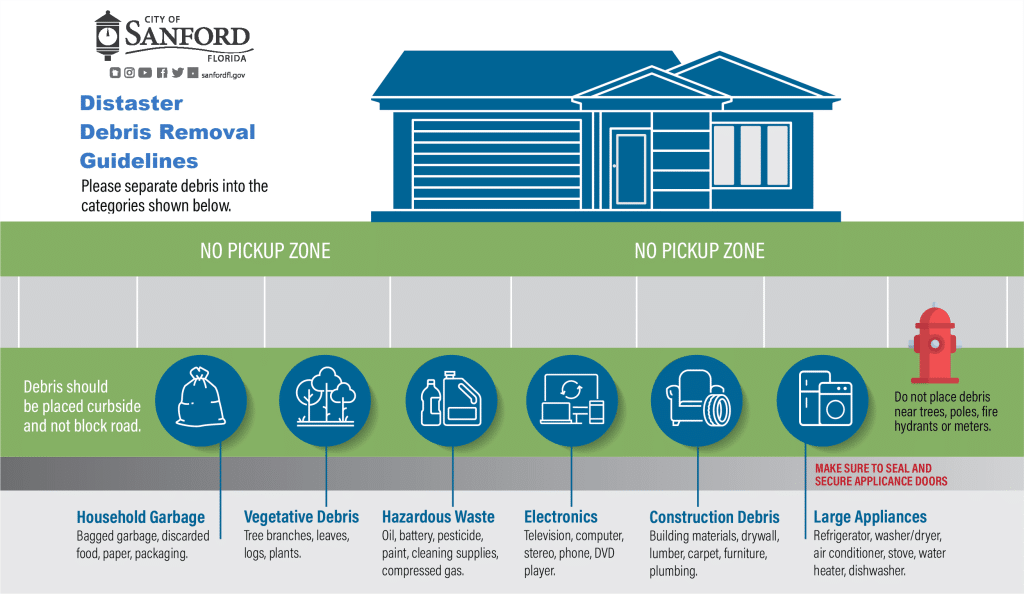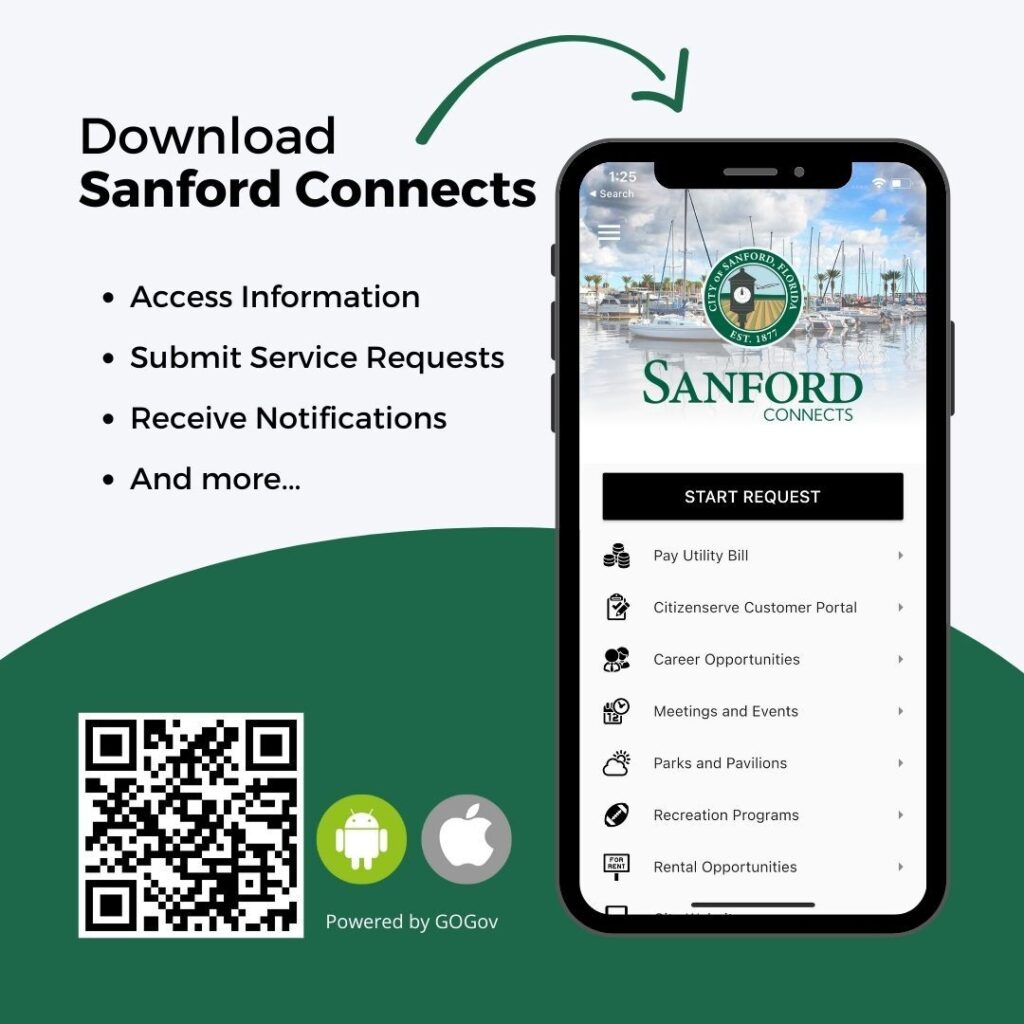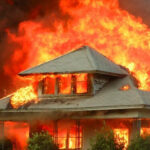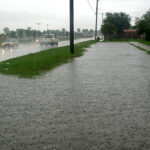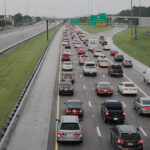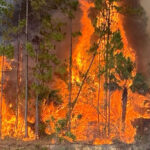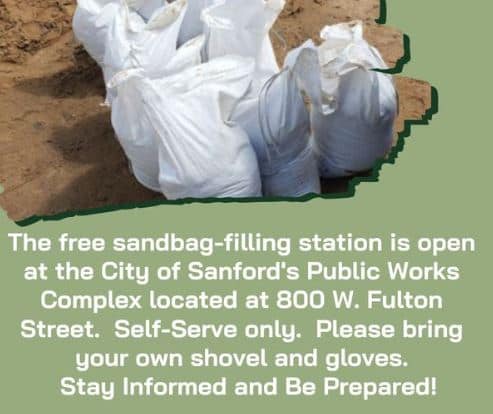
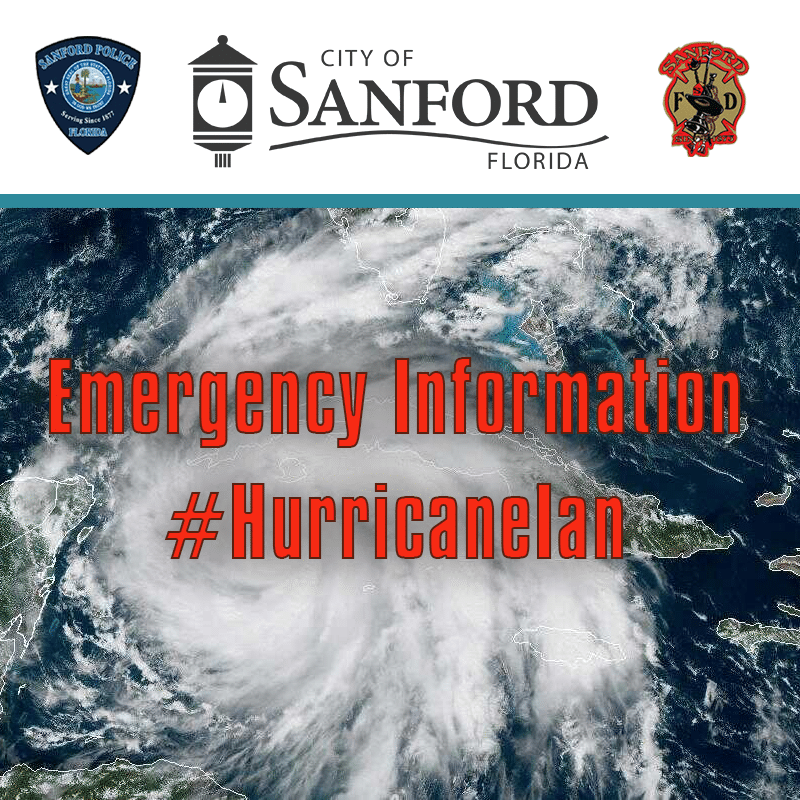
The City will distribute timely updates. We encourage you to monitor our social channels and consider downloading our mobile app, Sanford Connects to keep up with the most recent information.
The City will distribute timely updates. We encourage you to monitor our social channels and consider downloading our mobile app, Sanford Connects to keep up with the most recent information.
Due to record rainfall and excessive flows to the Water Reclamation Facility near Lake Monroe,
treated reclaimed water overflowed from the City’s facilities into the lake and river. Until further notice, no swimming and fishing, along the south shore of Lake Monroe from Sanford’s Mellonville Avenue to Seminole County’s Lake Monroe Wayside Park. This is in conjunction with the Florida Department of Health Seminole County and the Florida Department of Environmental Protection. The ban on swimming and fishing will continue until conditions warrant lifting.
Stay out of floodwater.
- Floodwater can contain many things that may harm health, including germs, dangerous chemicals, human and livestock waste, wild or stray animals, downed power lines, and other contaminants that can make you sick.
- Wash your hands with soap and water if you have been in floodwater. If you don’t have soap or water, use alcohol-based wipes or sanitizer.
- Always follow warnings about flooded roads.
- Don’t drive in flooded areas—cars or other vehicles won’t protect you from floodwaters. They can be swept away or may stall in moving water.
- If you have to be in or near floodwater, wear a life jacket—especially if the water is rising.
Disaster Recovery Center for Seminole County
Current Information
The City has 2 Sandbag stations available: 800 West Fulton Street, and 18th Street Park, 1715 W. 18th Street, from 8 am – 8pm. Please be sure to bring your own shovel and gloves. The limit is 15 bags per person.
SANDBAG DISPOSAL:
- If your sandbags contacted flood water, we consider them contaminated as that water may have contained sewage, oil, or chemicals. Contaminated sandbags should be handled with Personal Protective Equipment (eyewear and gloves) and be taken to the Seminole County Landfill (1930 E Osceola Rd, Geneva).
- Uncontaminated bags may be stored on your property for reuse in later events if properly dry. If wet, the bags will start to deteriorate over time and mold can form. Uncontaminated bags can be emptied on your property and the bags disposed of in your normal trash. Uncontaminated, full sandbags may also be delivered to Seminole County Landfill.
Last updated 08/29/2023
Schools
Seminole County Public Schools will resume regular school operations as well as all scheduled events and extra-curricular activities on Thursday, August 31. 2023.
City Hall
Sanford City Hall and all City Facilities will re-open at 7AM on Thursday, August 31, 2023. An assessment of the City showed there was no flooding or damages due to the storm effects of Hurricane Idalia.
Last updated 08/30/2023
Regular scheduled collection services will resume on Thursday, August 31, 2023.
Last Updated 08/30/23
The Parks and Recreation Department will re-open all rental facilities and parks on Thursday, August 31, 2023 following staff’s assessment of any storm damage. All programs for adult, youth sports and seniors will also proceed as regularly scheduled on Thursday.
Last updated 08/30/2023
The City of Sanford’s Public Works and Utility Departments have been diligently prepping for hurricane Idalia. Vacuum sewer is fully functional. Staff is prepped and ready to respond to any Public Works and Utility needs.
Household Yard Waste
For storm debris collection details, please call the Citizen Information Line at 407.562.2778 Option 6.
Thank you for your patience and understanding!
DO NOT put vegetative debris in plastic bags. Make piles, use bins, or paper bags.
Separate vegetative waste (branches, logs, palm fronds, leaves) from construction and demolition debris (building materials, other large items) in two piles at the curbside.
Keep your storm debris piles off the roadway, sidewalks, stormwater drains, away from fire hydrants, and mailboxes, etc. For any questions or concerns, please contact the Public Works Department at 407-688-5080 or through the City’s mobile app Sanford Connects. Thanks to FEMA, please see this graphic that demonstrates specific details. We thank you for your cooperation.
Things to remember while cleaning up:
PLACE ALL STORM DEBRIS ON THE PUBLIC “RIGHT-OF-WAY”.
- The public right-of-way is the area of residential property that extends from the street to the sidewalk, ditch, utility pole, or easement.
- Debris should be placed in the right-of-way, next to the street, but not in the street. Please be careful not to block storm drains, sidewalks, meter boxes, or fire hydrants.
- Do NOT set debris against any water meter vault, above-ground utility, trees, or poles. Doing so makes it harder for cleanup crews to scoop up the items.
- Different types of debris will be picked up on separate passes.
SEPARATE DEBRIS INTO CATEGORIES / PILES:
- Household Garbage: Bagged trash, discarded food, packaging, and papers. All garbage should be placed curbside the night before pickup as directed by the City.
- Construction Debris: Building materials, drywall, lumber, carpet, furniture, mattresses, plumbing materials.
- Vegetative Debris: Tree branches, leaves, logs, cuttings.
- Household Hazardous Waste: Oils, batteries, pesticides paints, cleaning supplies, aerosol sprays compressed gas.
- Appliances (‘White’ Goods): Refrigerators, dryers, washers, freezers, air conditioners, stoves, water heaters, and dishwashers. Secure appliance doors with duct tape.
- Electronics: Televisions, computers, radios, stereos, DVD Players, telephones.
Last updated 08/29/2023
IF YOU ARE UNDER A HURRICANE WARNING, FIND SAFE SHELTER RIGHT AWAY
- Determine how best to protect yourself from high winds and flooding.
- Listen for emergency information and alerts.
- Only use generators outdoors and away from windows.
- Turn Around, Don’t Drown! Do not walk, swim, or drive through flood waters.
- Know your area’s risk of hurricanes.
- Sign up for Alert Seminole. The Emergency Alert System (EAS) and National Oceanic and Atmospheric Administration (NOAA) Weather Radio also provide emergency alerts.
- If you are at risk for flash flooding, watch for warning signs such as heavy rain.
- Practice going to a safe shelter for high winds, such as a FEMA safe room or ICC 500 storm shelter. The next best protection is a small, interior, windowless room in a sturdy building on the lowest level that is not subject to flooding.
- Based on your location and community plans, make your own plans for evacuation or sheltering in place.
- Become familiar with your evacuation zone, the evacuation route, and shelter locations.
- Gather needed supplies for at least three days. Keep in mind each person’s specific needs, including medication. Don’t forget the needs of pets.
- Keep important documents in a safe place or create password-protected digital copies.
- Protect your property. Declutter drains and gutters. Install check valves in plumbing to prevent backups. Consider hurricane shutters. Review insurance policies.
- Bookmark your city or county website for quick access to storm updates and emergency instructions.
- Bring loose, lightweight objects inside that could become projectiles in high winds (e.g., patio furniture, garbage cans); anchor objects that would be unsafe to bring inside (e.g., propane tanks); and trim or remove trees close enough to fall on the building.
- Cover all of your home’s windows. Permanent storm shutters offer the best protection for windows. A second option is to board up windows with 5/8” exterior grade or marine plywood, cut to fit and ready to install.
- Turn on your TV/radio, or check your city/county website every 30 minutes in order to get the latest weather updates and emergency instructions.
- Charge your cell phone now so you will have a full battery in case you lose power.
- If you’re not in an area that is recommended for evacuation, plan to stay at home or where you are and let friends and family know where you are.
- Close storm shutters, and stay away from windows. Flying glass from broken windows could injure you.
- Turn your refrigerator or freezer to the coldest setting and open only when necessary. If you lose power, food will last longer. Keep a thermometer in the refrigerator to be able to check the food temperature when the power is restored.
- Turn on your TV/radio, or check your city/county website every 30 minutes in order to get the latest weather updates and emergency instructions.
- If told to evacuate, do so immediately. Do not drive around barricades.
- If sheltering during high winds, go to a FEMA safe room, ICC 500 storm shelter, or a small, interior, windowless room or hallway on the lowest floor that is not subject to flooding.
- If trapped in a building by flooding, go to the highest level of the building. Do not climb into a closed attic. You may become trapped by rising flood water.
- Listen for current emergency information and instructions.
- Use a generator or other gasoline-powered machinery outdoors ONLY and away from windows.
- Do not walk, swim, or drive through flood waters. Turn Around. Don’t Drown! Just six inches of fast-moving water can knock you down, and one foot of moving water can sweep your vehicle away.
- Stay off of bridges over fast-moving water.
- Listen to authorities for information and special instructions.
- Be careful during clean-up. Wear protective clothing and work with someone else.
- Do not touch electrical equipment if it is wet or if you are standing in water. If it is safe to do so, turn off electricity at the main breaker or fuse box to prevent electric shock.
- Avoid wading in flood water, which can contain dangerous debris. Underground or downed power lines can also electrically charge the water.
- Save phone calls for emergencies. Phone systems are often down or busy after a disaster. Use text messages or social media to communicate with family and friends.
- Document any property damage with photographs. Contact your insurance company for assistance.
Hurricane Preparedness For Your Yard
Is your yard ready for hurricane season?
When it comes to the cutting of vegetation, garbage and storm debris, there are steps that should be taken before, during and after a storm.
All major cutting of vegetation should be completed long before June 1, the beginning of hurricane season. The City of Sanford arranges for removal of yard debris from routine yard maintenance weekly throughout the year. If you are having trees removed or doing any other major cutting, be sure to have your contractor include the price of debris removal as part of their service.
All major cutting of vegetation should be completed long before June 1, the beginning of hurricane season. The City of Sanford arranges for removal of yard debris from routine yard maintenance weekly throughout the year. If you are having trees removed or doing any other major cutting, be sure to have your contractor include the price of debris removal as part of their service.
- Do not cut down trees or do major yard work.
- Do not begin construction projects that produce debris.
- Mass cutting places a tremendous burden on the collection process and there is not enough equipment or manpower to handle the additional material before a storm makes landfall. You could not only put yourself at risk but your neighbors as well.
- Keep all household garbage, recycling, vegetation and storm debris separate. This is extremely important!
- Place household garbage in CLEAR plastic bags to expedite wet waste removal.
- Be patient!
- Don’t call and ask that trucks be pulled from scheduled routes to pick up your own debris first. Deviation from carefully planned routes causes delays in the entire process.
Separating Your Debris
